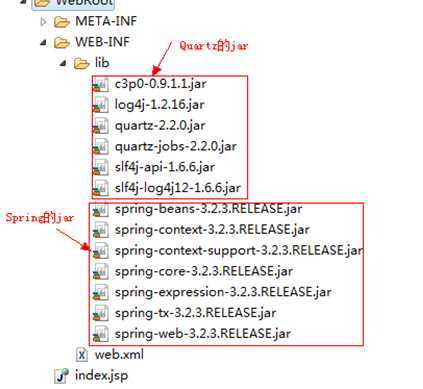标签:

1. 首先需要引入需要的jar包,如上图所示。
2. 编写需要定时调度的测试类:
package com.jp.task; import java.util.Date; public class TestTask{ private static int counter = 0; protected void execute() { long ms = System.currentTimeMillis(); System.out.println("\t\t" + "========================================" + new Date(ms)); System.out.println("(" + counter++ + ")"); } }
3.编写配置文件classpath:quartz.xml,放在工程的src目录下:
<?xml version="1.0" encoding="UTF-8"?> <beans xmlns="http://www.springframework.org/schema/beans" xmlns:xsi="http://www.w3.org/2001/XMLSchema-instance" xmlns:aop="http://www.springframework.org/schema/aop" xmlns:tx="http://www.springframework.org/schema/tx" xsi:schemaLocation=" http://www.springframework.org/schema/beans http://www.springframework.org/schema/beans/spring-beans-3.0.xsd http://www.springframework.org/schema/aop http://www.springframework.org/schema/aop/spring-aop-3.0.xsd http://www.springframework.org/schema/tx http://www.springframework.org/schema/tx/spring-tx-3.0.xsd"> <!-- 定义目标bean和bean中的方法 --> <bean id="SpringQtzJob" class="com.jp.task.TestTask"/> <bean id="SpringQtzJobMethod" class="org.springframework.scheduling.quartz.MethodInvokingJobDetailFactoryBean"> <property name="targetObject"> <ref bean="SpringQtzJob"/> </property> <property name="targetMethod"> <!-- 要执行的方法名称 --> <value>execute</value> </property> </bean> <!-- ======================== 调度触发器 ======================== --> <bean id="CronTriggerBean" class="org.springframework.scheduling.quartz.CronTriggerFactoryBean"> <property name="jobDetail" ref="SpringQtzJobMethod"></property> <property name="cronExpression" value="0/5 * * * * ?"></property> </bean> <!-- ======================== 调度工厂 ======================== --> <bean id="SpringJobSchedulerFactoryBean" class="org.springframework.scheduling.quartz.SchedulerFactoryBean"> <property name="triggers"> <list> <ref bean="CronTriggerBean"/> </list> </property> </bean> </beans>
4.设置Spring启动时就加载quartz的配置文件,需要在web.xml中加上下面的代码:
<listener>
<description>spring监听器</description>
<listener-class>org.springframework.web.context.ContextLoaderListener</listener-class>
</listener>
<context-param>
<param-name>contextConfigLocation</param-name>
<param-value>classpath:bean.xml;classpath:quartz.xml</param-value>
</context-param>
5.关于cronExpression表达式,这里讲解一下,就是第3步配置文件中的value="0/5 * * * * ?"
秒 0-59 , - * /
分 0-59 , - * /
小时 0-23 , - * /
日期 1-31 , - * ? / L W C
月份 1-12 或者 JAN-DEC , - * /
星期 1-7 或者 SUN-SAT , - * ? / L C #
年(可选) 留空, 1970-2099 , - * /
表达式意义
"0 0 12 * * ?" 每天中午12点触发
"0 15 10 ? * *" 每天上午10:15触发
"0 15 10 * * ?" 每天上午10:15触发
"0 15 10 * * ? *" 每天上午10:15触发
"0 15 10 * * ? 2005" 2005年的每天上午10:15触发
"0 * 14 * * ?" 在每天下午2点到下午2:59期间的每1分钟触发
"0 0/5 14 * * ?" 在每天下午2点到下午2:55期间的每5分钟触发
"0 0/5 14,18 * * ?" 在每天下午2点到2:55期间和下午6点到6:55期间的每5分钟触发
"0 0-5 14 * * ?" 在每天下午2点到下午2:05期间的每1分钟触发
"0 10,44 14 ? 3 WED" 每年三月的星期三的下午2:10和2:44触发
"0 15 10 ? * MON-FRI" 周一至周五的上午10:15触发
"0 15 10 15 * ?" 每月15日上午10:15触发
"0 15 10 L * ?" 每月最后一日的上午10:15触发
"0 15 10 ? * 6L" 每月的最后一个星期五上午10:15触发
"0 15 10 ? * 6L 2002-2005" 2002年至2005年的每月的最后一个星期五上午10:15触发
"0 15 10 ? * 6#3" 每月的第三个星期五上午10:15触发
每天早上6点
0 6 * * *
每两个小时
0 */2 * * *
晚上11点到早上8点之间每两个小时,早上八点
0 23-7/2,8 * * *
每个月的4号和每个礼拜的礼拜一到礼拜三的早上11点
0 11 4 * 1-3
1月1日早上4点
0 4 1 1 *
6.还要需要多个任务时的情况,参考:http://nesuk.iteye.com/blog/1582557
关于Spring集成Quartz的concurrent属性
以前经常在任务调度程序中使用Spring集成的Quartz,这种方式可以用简单的声明式配置即可实现定时任务,并结合了Spring自身的Bean的管理功能,非常方便。配置样本如下:
<bean id="transmitTask" class="org.springframework.scheduling.quartz.MethodInvokingJobDetailFactoryBean"> <property name="targetObject"> <ref bean="transTaskBusiness" /> </property> <property name="targetMethod"> <value>execute</value> </property> <property name="concurrent"> <value>false</value> </property> </bean>
其中concurrent属性标识的解释为:对于相同的JobDetail,当指定多个Trigger时,
很可能第一个job完成之前,第二个job就开始了。指定concurrent设为false,多个job不会并发运行,第二个job将不会在第一个job完成之前开始。
那么此处的第二个job到底是被推迟执行了,还是被取消了呢?
今天带着这个疑问做了一个小实验,具体做法如下:将任务的Trigger设置为每10秒钟执行一次,然后在执行的任务体内让Thread暂停15秒钟,这样不同的job之间肯定会有时间上的重叠。当启动程序之后,发现前一个job执行结束的时刻的秒数为15,而且第二个本来在10s就执行的job马上就启动了。
标签:
原文地址:http://www.cnblogs.com/lnlvinso/p/4194725.html